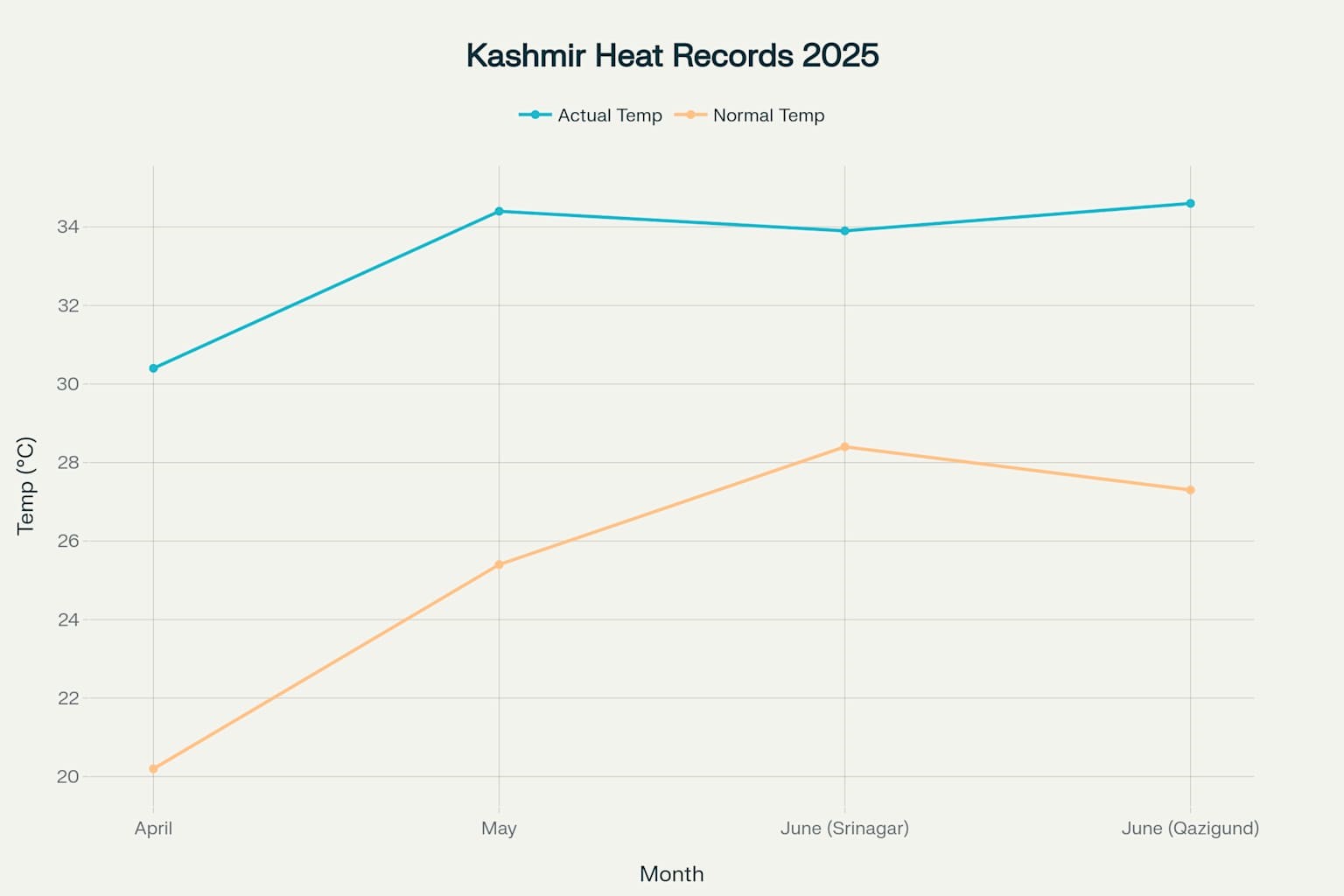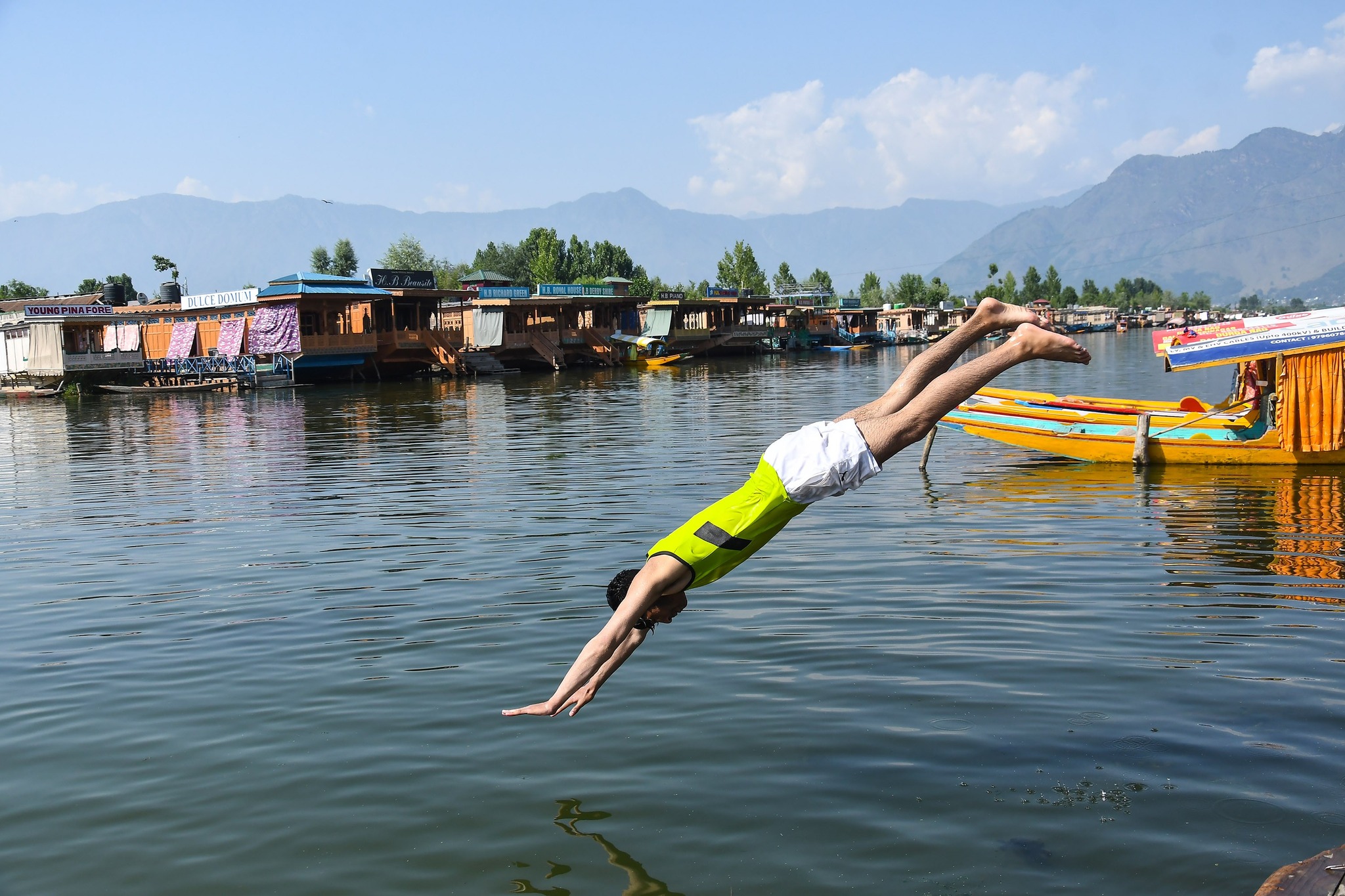A paradise once cooled by alpine winds now scorches under record-breaking temperatures. As Kashmir sweats through its hottest year in history, the question looms: can the valley adapt before it burns out?
By Ajaz Rashid
 The thermometer in Srinagar’s meteorological office registered an unprecedented 34.6°C, it equaled its 3rd highest recorded temperature for June since 1962. As Kashmir swelters under what experts call its most severe climate crisis in recorded history, the region once celebrated as “Paradise on Earth” now confronts an uncertain and increasingly hostile weather future that threatens its very identity
The thermometer in Srinagar’s meteorological office registered an unprecedented 34.6°C, it equaled its 3rd highest recorded temperature for June since 1962. As Kashmir swelters under what experts call its most severe climate crisis in recorded history, the region once celebrated as “Paradise on Earth” now confronts an uncertain and increasingly hostile weather future that threatens its very identity
The statistics paint a stark picture of accelerating climate breakdown. Kashmir has experienced its hottest April in 78 years, with temperatures soaring 10.2°C above normal, while an unprecedented 80% precipitation deficit during the critical winter months of January and February 2025 has triggered the first drought warnings in the region’s modern history
Record-Breaking Heat Reshapes the Valley
 Kashmir’s temperature revolution began in earnest this year, with each month bringing new extremes that would have been unthinkable just decades ago. April 15, 2025, marked a turning point when Srinagar recorded 30.4°C, becoming the hottest April day in nearly eight decades. The pattern continued relentlessly through May and into June, with meteorological stations across the valley registering temperatures consistently 5-7°C above seasonal norms.
Kashmir’s temperature revolution began in earnest this year, with each month bringing new extremes that would have been unthinkable just decades ago. April 15, 2025, marked a turning point when Srinagar recorded 30.4°C, becoming the hottest April day in nearly eight decades. The pattern continued relentlessly through May and into June, with meteorological stations across the valley registering temperatures consistently 5-7°C above seasonal norms.
The June heatwave has proven particularly brutal, with Jammu reaching 44.4°C and ranking as the 68th hottest place globally on June 12, 2025. Qazigund, the gateway to Kashmir Valley, equaled its third-highest June temperature since 1962 at 34.6°C, while even traditionally cooler hill stations like Gulmarg recorded an unusual 24.0°C. Independent weather forecaster Faizan Arif warns that “Kashmir is warming at more than double the global average due to greenhouse gas emissions”
A 2025 report by Directorate of Health says that the health implications have been immediate and severe. Heat stress calls and hospital admissions have surged by 200% between 2020 and 2025, with vulnerable populations including the elderly, children, and outdoor workers bearing the brunt of the crisis. The government has responded by implementing the Srinagar Heat Wave Action Plan 2024-25, urging residents to avoid outdoor activities between 11 AM and 4 PM
When Historic Springs Run Dry
 Perhaps no single event captures Kashmir’s water crisis more dramatically than the complete drying of the Achabal Spring in February 2025—the first time in recorded history that this 17th-century Mughal garden’s water source has failed. Built by Empress Nur Jahan, the spring traditionally supplied water to nearly 20 villages and supported 15 water supply schemes serving approximately 100,000 people.
Perhaps no single event captures Kashmir’s water crisis more dramatically than the complete drying of the Achabal Spring in February 2025—the first time in recorded history that this 17th-century Mughal garden’s water source has failed. Built by Empress Nur Jahan, the spring traditionally supplied water to nearly 20 villages and supported 15 water supply schemes serving approximately 100,000 people.
The crisis extends far beyond individual springs. The Jhelum River, Kashmir’s lifeline, has dropped to unprecedented lows, with water levels falling to -1.01 feet at Sangam and 3.52 feet at Ram Munshi Bagh in Srinagar. Officials from the Irrigation and Flood Control Department report that the river is experiencing “below zero flow” conditions for the first time in memory.8
Spring discharge rates have plummeted dramatically, with Colony Bagh in Baramulla recording a 74% decline between November 2023 and November 2024, and Parigam Bala in Kulgam showing a 42% reduction.
The iconic Dal Lake, already shrunk from 22 to 18 square kilometers due to decades of encroachment and pollution, now faces additional stress from the unprecedented dry conditions. Residents report reduced water supply hours, with some areas experiencing multi-day water cuts as authorities deploy tankers to maintain basic supplies
Economic Devastation Across All Sectors
Kashmir’s climate crisis has unleashed economic devastation across every major sector of the regional economy. The agriculture sector, employing nearly 70% of the population, has been particularly hard hit, with apple crops suffering 20% destruction in Shopian district alone due to extreme weather events. High-density apple orchards, representing significant farmer investments, have reported losses exceeding ₹10 lakh per orchard following devastating windstorms and hailstorms.
Kashmir’s climate crisis devastates the economy with half of the saffron production decline, and hydropower generation falling to just 17% capacity
The region’s world-renowned saffron industry faces an existential crisis, with production declining by 50% due to prolonged dry spells 309. The prestigious Khelo India Winter Games were postponed due to inadequate snowfall, dealing another blow to the region’s winter sports reputation.
The Human Cost of Climate Change
 Behind the statistics lie human stories of adaptation and resilience in the face of unprecedented environmental pressure. In rural areas, women walk five to six kilometers daily to collect water, navigating icy paths and steep terrain as traditional water sources disappear. Farmers report having to dig deeper wells while simultaneously watching their crops fail due to erratic weather patterns.
Behind the statistics lie human stories of adaptation and resilience in the face of unprecedented environmental pressure. In rural areas, women walk five to six kilometers daily to collect water, navigating icy paths and steep terrain as traditional water sources disappear. Farmers report having to dig deeper wells while simultaneously watching their crops fail due to erratic weather patterns.
The psychological impact on communities runs deep. Sheikhzada Skindar , a 65-year-old villager from south Kashmir, told reporters: “It is the first time I have seen the spring dried up. I have never seen this situation before”. Such testimonies reflect a broader sense of ecological mourning as landscapes that sustained communities for generations undergo rapid transformation.
Educational institutions have been forced to adapt quickly, with schools suspending outdoor activities during peak heat hours and implementing new protocols to protect children from heat-related illnesses. The government has issued specific guidelines emphasizing that children are particularly susceptible to heat stress, requiring frequent water breaks and constant monitoring for symptoms of heat exhaustion.
Healthcare systems are struggling to cope with the surge in climate-related health issues. Heat-related illnesses including dehydration, particularly affecting outdoor workers, the elderly, and children. The Directorate of Health Services has developed a State Action Plan on Climate Change and Human Health to address these mounting challenges.
Government Response and Adaptation Efforts
Recognizing the severity of the crisis, the Jammu and Kashmir government has launched multiple initiatives to address climate impacts and build resilience. The state-specific Climate Change Action Plan, dormant for nearly a decade, was revived in 2023 and focuses on both adaptation and mitigation strategies.
Research institutions are playing a crucial role in developing climate adaptation strategies. The University of Kashmir has launched a Green Campus Initiative in partnership with Delhi-based Yok Solutions, aiming for zero waste to landfill and promoting sustainable practices. The Environmental Policy Group, in collaboration with the Institution of Engineers (India), has submitted comprehensive policy recommendations to address climate change impacts across water resources, agriculture, and public health.
Climate researchers emphasize that the current crisis represents more than statistical changes—it threatens the fundamental character of a region whose identity has been shaped by its unique climate for millennia. According to a news report published in kashmirpost.org, Dr. Aijaz Mir, a climate scientist at the University of Kashmir, notes: “We’re seeing the consequences of global warming play out in real time. This isn’t just a hot spell—it’s part of a larger pattern of erratic and extreme weather”
Adaptation and the Path Forward
Despite the mounting challenges, experts and local communities are developing innovative approaches to climate resilience. Agricultural scientists at Sher-e-Kashmir University of Agricultural Sciences and Technology (SKUAST) have developed climate-resilient crop varieties, including high-yielding and disease-resistant strains of rice, maize, and wheat specifically adapted to Kashmir’s changing conditions.
The development of climate-smart agricultural practices includes promoting drought-resistant crops, implementing micro-irrigation techniques, and supporting crop diversification to reduce vulnerability to weather extremes. Traditional water management systems, including the restoration of historic kul (water channels), are being revived alongside modern conservation technologies.
Young Kashmiris are increasingly engaged in climate action, organizing clean-up campaigns, starting eco-tourism ventures, and raising awareness through education and social media. The University of Kashmir’s Department of Environmental Science, celebrating World Environment Week 2025, continues its 25-year tradition of environmental education and public engagement.
An Uncertain Future
As Kashmir grapples with the reality of climate change, the region stands at a critical juncture between its storied past and an uncertain future. The breach of the 1.5°C warming threshold is no longer a distant threat but a lived reality requiring immediate and sustained action.
For a region that has sustained itself on snow-fed agriculture, tourism, and hydropower for centuries, the transformation represents both an existential challenge and an opportunity for innovation. As environmental scientist Mansha Nisar according to a local news agency, warns: “With no replenishment during the winter months, abnormally high temperatures force premature meltdown in perennial water reserves and glaciers. Unless we get compensatory rainfall during the coming months, the scene is horrifying”.
As the valley that once symbolized paradise on earth confronts an uncertain weather future, its experience offers sobering lessons for mountain regions worldwide facing similar climate pressures.
The stakes could not be higher. Kashmir’s climate future will determine whether this Himalayan paradise can adapt and thrive in a rapidly changing world, or whether it will become another casualty of the global climate crisis. With glaciers melting, springs drying, and temperatures soaring to record heights, the window for effective action continues to narrow with each passing season.

Leave a Reply